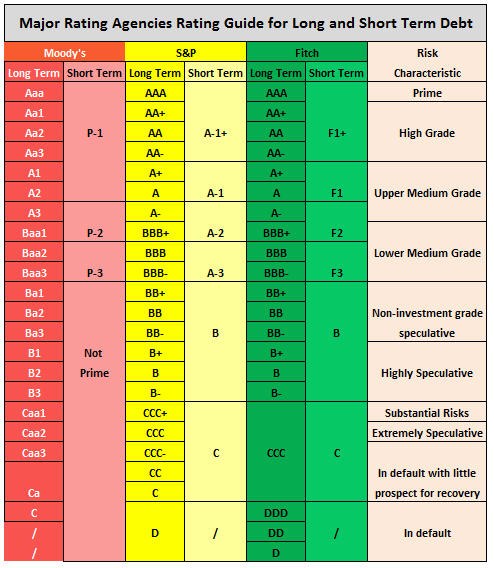
In April 2016, Moody’s Investment Services Limited downgraded Trinidad and Tobago’s bond rating from Baa2 to Baa3 with a negative outlook. The above statement will likely mean very little to the average citizen, mainly because of a lack of knowledge about the purpose, reasons and consequences of credit ratings. However, the downgrading of a country’s credit rating is something that every citizen should note, particularly if there is a downward trend in the country’s credit rating (in other words, follows a previous downgrade). This article will cover some key concepts of which every citizen should be familiar.
What is a Credit Rating?
A credit rating is an assessment of the creditworthiness of a borrower, which is the ability of a borrower to repay its debt obligations. Typically, credit ratings are assigned to individuals, corporations, state enterprises or statutory authorities and sovereign governments.
Credit ratings of sovereign governments, such as Trinidad and Tobago, are performed by credit rating agencies.
What are credit rating agencies?
Credit rating agencies provide investors with information designed to assist in determining the likelihood of a borrower (corporation or government) to repay debt obligations (loans) and fixed-income securities (bonds). With respect to government, credit agency assess the ability of a government to repay its debt obligation, which are typically in the form of fixed income instruments or bonds.
The three largest credit rating agencies, that possess a status of “Nationally Recognized Statistical Rating Organizations” from the US Security Exchange Commission (SEC), are Fitch, Moody’s and Standard and Poor’s. Typically, credit rating agencies, such as Moody’s, make Staff Visits to the governments that hire them to rate their bonds.
What does the ratings mean?
Characteristically, credit rating agencies raise ratings for the debt of corporations or governments to reflect lower credit risk. Alternatively, agencies will lower ratings to reflect higher credit risk or lower ability to repay debt obligations. As a result, lenders will require higher returns to compensate for higher risk.
The lowering of Trinidad and Tobago’s bond rating from Baa2 to Baa3, thus reveals Moody’s view that the country has a higher risk of defaulting on its debt obligations. Consequently, the ratings reveal a weakening economic environment for Trinidad and Tobago, which is a source of some concern for citizens, businesses and the government alike.
Why did Moody’s lower Trinidad and Tobago’s bond rating?
Sovereign credit ratings take into account the overall economic conditions that exist within a country. The agency performs an analysis of several factors including a country’s fiscal strength, foreign currency reserves, medium term strategic planning, policy response, institutional strength and market transparency.
Moody downgraded Trinidad and Tobago’s bond ratings based in April 2016 based on two key drivers:
- Low oil and gas prices.
“Despite the authorities’ fiscal consolidation efforts, low oil and gas prices will negatively and materially undermine the country’s economic and government financial strength at least throughout 2018.”
- Slow and insufficient policy response.
“There is a high likelihood that the policy response to the commodity price shock will not be as timely and effective as required due to lack of macroeconomic data and weak policy execution capacity.”
How significant is the ratings of credit rating agencies?
Credit ratings impact the cost of borrowing for companies and governments. One of the fundamental rules of finance is the positive relationship between risk and reward, the higher the risk of lending funds, the higher the reward (interest rate) that a lender requires to provide funds. In this regard, investors rely on credit rating agencies to provide them with a guide to the level of interest rates to issue to borrowers. As such, a downgrade of Trinidad and Tobago’s debt may lead to an increase in borrowing cost for future borrowings, which means high debt obligations in the medium and long term.
Notably, the original business model for credit rating services was one in which investors would pay to subscribe to rating agency services and borrowers did not pay fees for the publication of an agency’s research and analysis. However, the current model is one in which the credit rating agencies are hired by corporate and government borrowers themselves to provide them with credit ratings. This presents an obvious conflict of interest as agencies may be less inclined to give negative ratings to organizations that are essentially responsible for its bottom line. This concern was brought to the forefront in the 2008/2009 financial crisis, in which many credit rating agencies provided top ratings to subprime mortgage securities that were at the heart of the collapse of large financial powerhouses such as Lehman Brothers and Merrill Lynch.
Conclusion
Moody’s downgrade of Trinidad and Tobago’s bond rating with a negative outlook is one of many indicators that the country is facing a weak economic environment. Oil and gas is the main source of revenue for the country and as such lower prices has a major impact on revenue generation. Lower revenue generation could lower government’s ability to spend on education and healthcare, infrastructure and social programs. The changing of the requirements to receive free education at tertiary level, facilitated by the GATE programme, is one such side effect of a lower oil and gas prices.
Further, lower prices mean an increased fiscal deficit, which would require a combination of higher taxes (to raise revenue) and increased borrowing (to bridge the gap between revenue and expenditure), which results rising government debt. The latter effect will place additional pressure on the country’s debt sustainability as lower ratings will mean higher borrowing costs.
The government needs an immediate policy response to deal with the fall in expenditure as well as medium to long term plans to diversify Trinidad and Tobago’s economy into other viable export channels.
By,
Jade De Labastide (MSc., BSc.)
JDL Business
